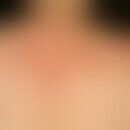HistoryThis section has been translated automatically.
Synonyms
- Acute uric acid nephropathy: uric acid infarction without necrosis; part of tumour lysis syndrome;
- Chronic uric acid nephropathy: gouty kidney; gouty nephropathy;
First author
In 1683, Thomas Sydenham (1624 - 1689), who himself suffered from gout for more than 30 years, wrote his famous treatise on gout (Schuchart 2018).
DefinitionThis section has been translated automatically.
Acute uric acid nephropathy is understood to be precipitation of uric acid in the presence of massive cell decay of varying genesis (Keller 2010). In the chronic form, in addition to the precipitation of uric acid as a result of hyperuricemia, there is also a reduced ability to excrete uric acid (Schewe 2015).
You might also be interested in
ClassificationThis section has been translated automatically.
One differentiates between acute and chronic uric acid nephropathy (Thomas 2006).
OccurrenceThis section has been translated automatically.
Acute uric acid nephropathy:
Acute uric acid nephropathy first develops physiologically in newborns on the 1st - 3rd day of life (Thomas 2006).
It can otherwise occur at any age.
Chronic uric acid nephropathy:
Chronic uric acid nephropathy is rarely found nowadays, as now the treatment options for hyperuricemia are very good (Tsvetkov 2020).
It is most common in patients with long-standing hyperuricemia and marked gouty tophi (Kasper 2015).
Renal changes occur in about 60% of patients suffering from gout, and of these, typical uric acid nephropathy develops in about 30%. In the further course, progressive renal insufficiency occurs in about 10 % (Thomas 2006).
EtiologyThis section has been translated automatically.
Acute uric acid nephropathy:
Acute uric acid nephropathy in the newborn occurs due to massive destruction of nucleated erythrocytes (Thomas 2006). It is physiologically caused.
Due to a rapid cell decay, the acute form is frequently found in certain clinical pictures such as:
- haematological neoplasms
- aggressive lymphomas (especially lymphoblastic lymphoma and Burkitt's lymphoma)
- acute leukaemias
and less frequently in solid tumours such as:
- Germ cell tumors
- breast carcinoma
- bronchial carcinoma
Also rare in:
- plasmocytoma
- indolent lymphoma
(Schmoll 2006)
- Lesh-Nyhan syndrome
- Heat stroke
(Thomas 2006)
- Status epilepticus
- Myocardial infarction
(Zöllner 1990)
Additional risk factors for acute uric acid nephropathy include:
- pre-existing renal insufficiency
- Hypovolemia
- Treatment with thiazide diuretics
- Therapy with nephrotoxic substances such as:
- Aminoglycosides
- amphotericin B
- cyclosporine A
- NSAIDS
- Sulfonamides
(Thomas 2006)
Chronic uric acid nephropathy:
Nowadays, chronic uric acid nephropathy occurs in patients with long-standing hyperuricemia and pronounced gouty tophi (Kasper 2015). It is possible that the damage to the endothelial cells caused by hyperuricemia is a risk factor (Tsvetkov 2020).
PathophysiologyThis section has been translated automatically.
Excretion of uric acid, the end product of purine metabolism, occurs primarily in the kidney (about two-thirds) and partially in the intestine (less than one-third). (Herold 2021)
In the glomeruli, uric acid is first filtered and the majority is reabsorbed or actively secreted into the tubules (Schmoll 2006). Only about 10 % of the filtered uric acid is excreted in the final urine (Schmidt 2007).
Normal values of uric acid excretion:
- Women < 4.5 mmol / d and < 750 mg / d, respectively.
- Men: < 4.7 mmol / d and < 800 mg / d, respectively.
(Kuhlmann 2015)
Acute uric acid nephropathy:
Due to cytostatic tumor cell destruction and / or rapid cell turnover in tumor disease, the amount of uric acid to be filtered in the kidney increases sharply, with a high concentration of uric acid especially in the distal tubule. As soon as the production and excretion exceed the solubility in the urine, precipitation of uric acid occurs in the acidic milieu of the tubules, the renal collecting tubes and the renal medulla, which ultimately triggers acute uric acid nephropathy (Schmoll 2006).
Chronic uric acid nephropathy:
Due to the accumulation of uric acid crystals, in addition to intrarenal obstruction, there are also inflammatory processes that cause fibrotic changes - mainly in the medullary and papillary areas of the kidney.
In addition, patients with gout disease often have lipidemia and arterial hypertension, which in turn cause marked degenerative changes in the renal aterioles.
However, the exact interactions between hyperuricemia, hypertension and renal failure have not yet been fully clarified (Kasper 2015).
ClinicThis section has been translated automatically.
Acute uric acid nephropathy:
Clinically, a rather uncharacteristic picture develops. Symptoms of uremia may be present such as:
Less common are:
- Hematuria
- Flank pain
- Nephrolithiasis
(Schmoll 2006)
Chronic uric acid nephropathy:
In chronic uric acid nephropathy, the symptoms of gout are prominent such as:
- Podagra in acute gout attack
- Gouty tophi
- Urate stones
(Risler 2008)
LaboratoryThis section has been translated automatically.
Acute uric acid nephropathy:
The diagnosis can be confirmed by uric acid crystals in the urine.
Typical for an acute uric acid nephropathy is a uric acid to creatinine ratio of > 1 in the urine. A quotient < 1 suggests a different genesis of renal failure (Kasper 2015).
Chronic uric acid nephropathy:
- Glomerular filtration rate may be near normal at the onset of developing renal failure.
- Proteinuria
- The ability to concentrate urine decreases
(Kasper 2015)
HistologyThis section has been translated automatically.
Histologically, deposits of sodium urate are found in the affected kidney. The birefringent needles can be detected in polarized light in the clearings of the collecting ducts and in the interstitium. The foreign body reaction caused by them leads to the appearance of multinucleated giant cells. Histologically the picture corresponds to a tophus (Thomas 2006).
Sometimes fibrotic changes occur in the medullary and papillary areas of the kidney (Kasper 2015).
Differential diagnosisThis section has been translated automatically.
Acute uric acid nephropathy:
- hypovolemic acute renal failure
- bilateral obstructive nephrolithiasis
(Zöllner 1990)
Chronic uric acid nephropathy:
- juvenile hyperuricemic nephropathy = medullary medullary kidney type 2 (Kasper 2015)
- chronic lead nephropathy
- chronic glomerulonephritis
(Zöllner 1990)
Complication(s)This section has been translated automatically.
General therapyThis section has been translated automatically.
Acute uric acid nephropathy:
Oncological patients with risk factors (see above "Etiology") should be monitored closely in the initial phase of tumor therapy, both by laboratory chemistry and fluid balance (Schmoll 2006).
General measures recommended are:
- Hydration to achieve a urine volume of ≥ 3 l / d.
Drugs that inhibit the absorption of uric acid should be avoided at all costs. They include, for example:
- Acetylsalicylic acid
- Probenicid
- Thiazide diuretics
(Schmoll 2006)
Chronic uric acid nephropathy:
Dietary measures such as avoiding purine-containing foods (such as offal), meat extract (use vegetable broth instead of meat broth), shellfish, beans, peas, asparagus, spinach, coffee, tea, cocoa, etc. (Klein 2019).
Internal therapyThis section has been translated automatically.
Acute uric acid nephropathy:
Under chemotherapy, patients should receive:
- Allopurinol
Treatment should be started as early as 1 - 2 days before the start of therapy.
Recommended dosage: 2 x 300 mg p. o. / d
It should be noted that the dosage of 6- mercaptopurine and azathioprine should be reduced by one third to one quarter when allopurinol is administered at the same time.
(Schmoll 2006)
- Alkalinisation of the urine
Alkalinization of the urine leads to better solubility of uric acid (Kuhlmann 2015).
This can be done medicinally by acetazolamide or i.v. administration of sodium bicarbonate. The target pH value should be between 7 - 8 (Schmoll 2006).
- Rasburicase
The drug was introduced in 2001 (trade name Fasturtec R ) and is - despite the lack of studies - recommended in first-line therapy (Kuhlmann 2015). It converts uric acid into the more soluble allantoin. Patients with the above risk factors (see "Etiology") and patients with a highly aggressive chemotherapy-sensitive tumor should be treated in parallel with rasburicase. The duration of therapy depends on the laboratory and clinical course (Schmoll 2006).
Dosage recommendation:
Rasburicase 0.15 mg to 0.2 mg / kg KG in 0.9% NaCl solution with a total volume of 50 ml 1 x / d i. v. (Schmoll 2006) or in combination with the above-mentioned hydrogenation i. v. (Kuhlmann 2015).
Chronic uric acid nephropathy:
Since uric acid crystallizes at acidic pH- values and returns to solution in an alkaline environment, this can be used therapeutically (Seitz 2018).
- Alkalinization of urine
In order to raise the urine to a pH between 6.5 to 6.8 for metaphylaxis, alkali citrate or sodium bicarbonate can be used. The dose required for this varies greatly from individual to individual and should be determined by the patient himself by taking measurements several times a day.
The dissolution of uric acid stones is done medicinally with e.g. potassium citrate. The dosage must also be adjusted individually here, but until the pH value is alkalized to 7.0 - 7.2 (Seitz 2018).
- Allopurinol
Medicinal lowering of uric acid levels in the blood and / or urine by allopurinol. Recommended dosage: 100 mg - 300 mg / d (Seitz 2018).
PrognoseThis section has been translated automatically.
Acute uric acid nephropathy:
Complete regression of renal damage is possible with prompt adequate therapy (Zöllner 1990).
Chronic uric acid nephropathy:
The chronic form of uric acid nephropathy is usually not progressive with appropriate drug treatment (Zöllner 1990). Allopurinol even appears to halt the progression of nephropathy (Stefan 2007).
LiteratureThis section has been translated automatically.
- Herold G et al (2021) Internal medicine. Herold Publishing 124, 705 - 708
- Kasper D L et al (2015) Harrison's Principles of Internal Medicine. Mc Graw Hill Education 1795, 1862,
- Kasper D L et al (2015) Harrison's Internal Medicine. Georg Thieme Verlag 2205, 2292
- Keller C K et al (2010) Practice of nephrology. Springer Verlag 155 - 156, 171 - 172
- Klein R (2019) 100 cases of general medicine: from the field. Elsevier Urban and Fischer Publishers 285
- Risler T et al (2008) Specialist nephrology. Elsevier Urban and Fischer Publishing 577
- Schewe S (2015) Gout. In: Lehnert H et al. DGIM Internal Medicine. Springer Medizin Verlag 1 - 12 https://doi.org/10.1007/978-3-642-54676-1_419-1.
- Schmidt R F et al (2007) Human physiology: with pathophysiology. Springer Verlag 698
- Schmoll H J et al (2006) Compendium of internal oncology: standards in diagnosis and therapy. Springer Verlag 2215 - 2217
- Schuchart S (2018) Famous discoverers of diseases: Thomas Sydenham, rebel at the bedside. Dtsch Arztebl 115 (12) 60
- Seitz C et al. (2018) S2k guideline on the diagnosis, therapy and metaphylaxis of urolithiasis (AWMF registry number 043 - 025).
- Stefan E G et al. (2007) Medical therapy 2007 / 2008. Springer Verlag 491
- Thomas C et al (2006) Histopathology: textbook and atlas on diagnostic findings and differential diagnosis. Schattauer Publishers 195
- Tsvetkov D et al (2020) Diagnosis and therapy internal medicine: chronic uric acid nephropathy. Publisher Harrison internal medicine e- chapters and videos. https://eref.thieme.de/cockpits/reader/clHAM0001clInn/coEndoSW00054/4-18
- Zöllner N et al (1990) Hyperuricemia, gout and other disorders of purine balance. Springer Verlag 217 - 220




